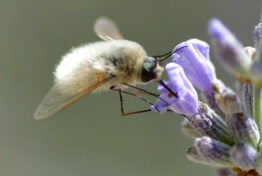Bee Flies
 Order: Diptera (flies)
Order: Diptera (flies)
Family: Bombyliidae
How to identify:
Because bee flies look similar to bees, with yellow-and-black striped, roundish bodies, the two are often confused. Bee flies only have one pair of wings (instead of two) with their back wings modified into “halteres,” very small, club-like wings. Furthermore, their compound eyes are much larger than a bee’s, making up the majority of their head.
Advanced Identification: The bee fly typically has a long, rigid proboscis, while the bee’s tongue can roll up when not in use (Moiset, n.d.). The wings have 3-4 posterior cells and the M1 vein ends at the wing tip (Borror & White, 1998).
Ecology
Metamorphosis Type: Complete Metamorphosis
Geographic Range: Bee flies are found in the warmer climates of North America (Moiset, B., USDA, 2021).
Habitat: Bee flies require a warm habitat and are most active in the spring and summer. Bee flies can be found in grasslands and forests where flowers are available (Hauze, n.d. & Moiset, n.d.).
Trophic Level: As larvae, they are parasitoids and eat the larvae of other egg and larval stage insects. As adults they are herbivores and eat the nectar of flowers (Moiset, n.d.).
Food: As adults bee flies use their long proboscis (straw-like projection from mouth) to reach deep into a flower for nectar.
Why should we care?
Human Uses: When people hear “pollination,” most people think “bees.” However, 70% of pollination is done by flies (Hooks, 2020)! Bee flies are considered more efficient pollinators than bees. The pollen sticks to a bee fly’s body every time they take nectar from the flower (Moiset, n.d.).
Conservation Status: Bombyliidae are not currently endangered and are considered in good standing (Hauze, n.d.).
Did you know?
- Bee flies are known to seek out warm patches on the ground to rest and heat themselves up during overcast days (Hauze, n.d.)
- Bee flies lay their eggs at the nest entrance of fellow insects (e.g., beetles and bumble bees). They quickly hover over and fling their eggs into the desired nest without even needing to land! Once in the larval stage, the bee fly will feast on the eggs of that insect. Once you familiarize yourself with identifying bee flies, you can observe this behavior too! (Moiset, n.d. ; Arndt & Costa, 2010).
- Bee flies do not require rearing of any sort. Once a female lays her eggs in the spring, the offspring are on their own for survival (Hauze 2021).
Image Credits
Photo 1: Jan-Cor Jacobs. 2019. Creative Commons License | Link
Photo 2. Cotinis. 2009. Creative Commons License | Link
Photo 3. Janet Graham. 2020. Creative Commons License | Link
Photo 4. Pdeley. 2015. Creative Commons License | Link
Photo 5. Jan-Cor Jacobs. Creative Commons License | Link
Photo 6 .Claude Dopagne. 2018. Creative Commons License | Link
Researcher’s Biography
Amalia Williams
Completed this research within Dr. Shelly Thomas’ Entomology course
Suggested Citation:
Williams, Amalia. (2021). Bee Flies. Rowan University Arboretum. https://arboretum.rowan.edu/learn/explore-insects/bee-flies/
Questions to Explore
- What is the significance of their hovering flight behavior? Does it enhance their foraging efficiency or predator avoidance?
- Do bee flies have a significant impact on host populations, considering their parasitic life cycle?
- How do bee flies communicate and perceive their environment?
- How efficient are bee flies as pollinators compared to bees?
- What role do bee flies play in the control of insect pests in agricultural and natural environments?
Citations
Borror, D. J., & White, R. E. (1998). Diptera. In A field guide to insects: America north of Mexico (pp. 278–278). essay, Houghton Mifflin.
Arndt, E. & Costa, C. (2010). Parasitism of Neotropical Tiger Beetles (Coleoptera: Carabidae: Cicindelinae) by Anthrax (Diptera: Bombyliidae). 36:(1). Taylor Francis Online. Retrieved December 2, 2021. | Link
Hauze, D. (n.d.). Bombylius. Animal Diversity Web. Retrieved December 2, 2021. | Link
Hooks, C. R., & Espindola, A. (2020, June 15). Flies and pollination: More than just aphid slayers and nuisances. Maryland Agronomy News. Retrieved November 30, 2021. | Link
Moiset, B. (n.d.). U.S. Forest Service. Forest Service Shield. Retrieved November 23, 2021.
| Link


